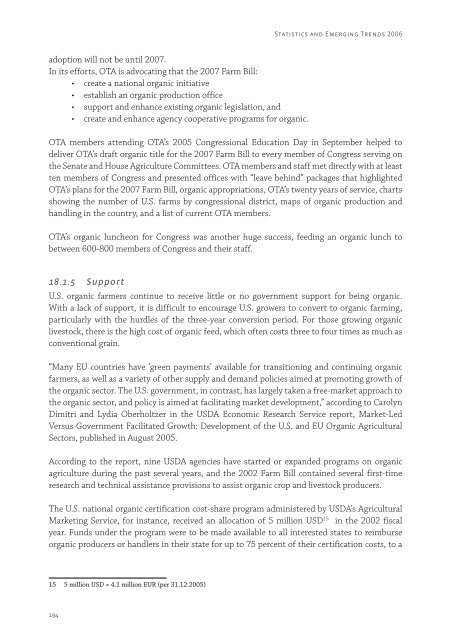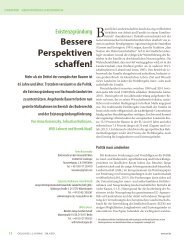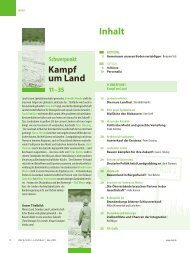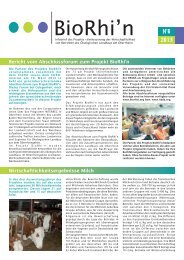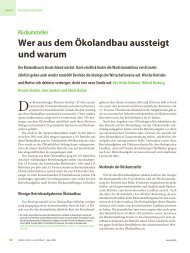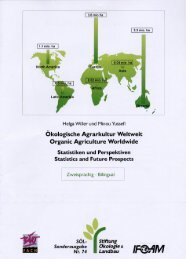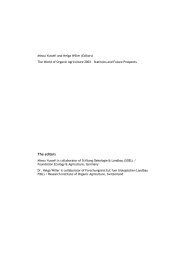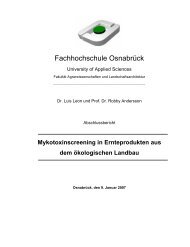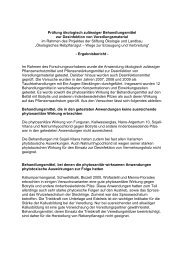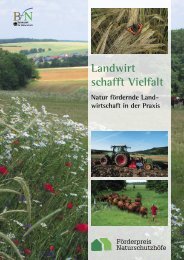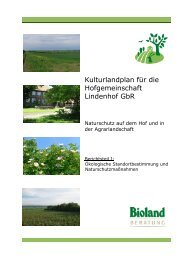the world of organic agriculture - Organic Eprints
the world of organic agriculture - Organic Eprints
the world of organic agriculture - Organic Eprints
Create successful ePaper yourself
Turn your PDF publications into a flip-book with our unique Google optimized e-Paper software.
adoption will not be until 2007.<br />
In its efforts, OTA is advocating that <strong>the</strong> 2007 Farm Bill:<br />
• create a national <strong>organic</strong> initiative<br />
• establish an <strong>organic</strong> production <strong>of</strong>fice<br />
• support and enhance existing <strong>organic</strong> legislation, and<br />
• create and enhance agency cooperative programs for <strong>organic</strong>.<br />
194<br />
Statistics and Emerging Trends 2006<br />
OTA members attending OTA’s 2005 Congressional Education Day in September helped to<br />
deliver OTA’s draft <strong>organic</strong> title for <strong>the</strong> 2007 Farm Bill to every member <strong>of</strong> Congress serving on<br />
<strong>the</strong> Senate and House Agriculture Committees. OTA members and staff met directly with at least<br />
ten members <strong>of</strong> Congress and presented <strong>of</strong>fices with “leave behind” packages that highlighted<br />
OTA’s plans for <strong>the</strong> 2007 Farm Bill, <strong>organic</strong> appropriations, OTA’s twenty years <strong>of</strong> service, charts<br />
showing <strong>the</strong> number <strong>of</strong> U.S. farms by congressional district, maps <strong>of</strong> <strong>organic</strong> production and<br />
handling in <strong>the</strong> country, and a list <strong>of</strong> current OTA members.<br />
OTA’s <strong>organic</strong> luncheon for Congress was ano<strong>the</strong>r huge success, feeding an <strong>organic</strong> lunch to<br />
between 600-800 members <strong>of</strong> Congress and <strong>the</strong>ir staff.<br />
18.1.5 Support<br />
U.S. <strong>organic</strong> farmers continue to receive little or no government support for being <strong>organic</strong>.<br />
With a lack <strong>of</strong> support, it is difficult to encourage U.S. growers to convert to <strong>organic</strong> farming,<br />
particularly with <strong>the</strong> hurdles <strong>of</strong> <strong>the</strong> three-year conversion period. For those growing <strong>organic</strong><br />
livestock, <strong>the</strong>re is <strong>the</strong> high cost <strong>of</strong> <strong>organic</strong> feed, which <strong>of</strong>ten costs three to four times as much as<br />
conventional grain.<br />
“Many EU countries have ‘green payments’ available for transitioning and continuing <strong>organic</strong><br />
farmers, as well as a variety <strong>of</strong> o<strong>the</strong>r supply and demand policies aimed at promoting growth <strong>of</strong><br />
<strong>the</strong> <strong>organic</strong> sector. The U.S. government, in contrast, has largely taken a free-market approach to<br />
<strong>the</strong> <strong>organic</strong> sector, and policy is aimed at facilitating market development,” according to Carolyn<br />
Dimitri and Lydia Oberholtzer in <strong>the</strong> USDA Economic Research Service report, Market-Led<br />
Versus Government Facilitated Growth: Development <strong>of</strong> <strong>the</strong> U.S. and EU <strong>Organic</strong> Agricultural<br />
Sectors, published in August 2005.<br />
According to <strong>the</strong> report, nine USDA agencies have started or expanded programs on <strong>organic</strong><br />
<strong>agriculture</strong> during <strong>the</strong> past several years, and <strong>the</strong> 2002 Farm Bill contained several first-time<br />
research and technical assistance provisions to assist <strong>organic</strong> crop and livestock producers.<br />
The U.S. national <strong>organic</strong> certification cost-share program administered by USDA’s Agricultural<br />
Marketing Service, for instance, received an allocation <strong>of</strong> 5 million USD 15 in <strong>the</strong> 2002 fiscal<br />
year. Funds under <strong>the</strong> program were to be made available to all interested states to reimburse<br />
<strong>organic</strong> producers or handlers in <strong>the</strong>ir state for up to 75 percent <strong>of</strong> <strong>the</strong>ir certification costs, to a<br />
15 5 million USD = 4.1 million EUR (per 31.12.2005)


